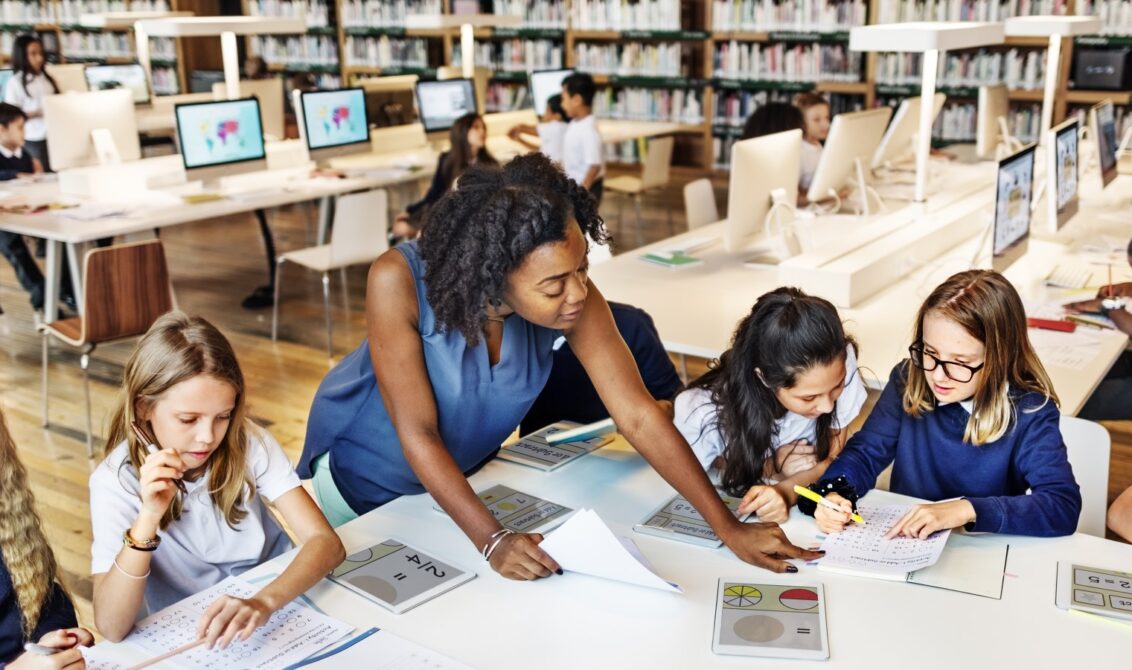
It’s the start of a new school year, and lots of teachers take this opportunity to reassess their classroom space and think about the way they can design it so that it is stimulating and welcoming, without distracting students from learning.
Clever classroom design can make a difference to your students’ energy levels, interactions, mood and concentration. So, let’s break it down and look at the five important factors to consider when you’re setting up your classroom for the coming academic year.
1. Flexibility
Over the last couple of decades, educators have been moving away from a teacher-centric approach, and that is reflected in classroom layout. Rows of desks all facing towards the teacher now feel a bit old-fashioned, and lots of teachers are opting for a flexible classroom layout that gives students a variety of options when it comes to their seating choices.
It’s a good idea to take into consideration the way that your students will be working. For example, if you want your students to spend lots of time working collaboratively, then grouping them around tables is a good way of promoting collaboration and communication. Research shows that movement improves learning, so you could arrange the furniture in a way that leaves space for students to get up, stretch, and move around every so often.
A popular approach is having different zones or areas in your classroom. For example, you could create a reading corner with a sofa and armchair. A few beanbags are another good option for a breakout zone for student discussion. Then, you could have an area with more traditional desks and chairs, which can be arranged into big tables for group work, or a U-shape for presentations and talks. Some teachers have even used standing desks in their classrooms.
2. Lighting
Lighting can make an enormous difference to the way that students work in your classroom. Natural lighting is the best thing for helping students to concentrate. Amazingly, one study found that students with the most daylight in their classrooms progressed 20% faster in maths and 23% faster in literacy in one year than students with the least amount of daylight.
So, it’s worth maximising the amount of natural light that your students are exposed to, for example by having their seating as close to the windows as possible, and using the darker side of the room for storage. Hanging a mirror opposite your classroom windows can create a second window effect, whereas putting a mirror adjacent to your windows will bounce more natural light into the classroom.
Another thing to consider is the kind of lighting that you’re using. Researchers in South Korea found that students performed better in tests where the room was lit with a cool, blueish-white light, whereas warm lighting provided a more relaxing ambience for breaktime activities.
3. Colour
Studies have shown that colour can have a big effect on the way that learners behave and respond in different rooms. So it’s worth doing a bit of research to discover how different shades affect people’s moods and behaviours in different ways. For example, green helps people to focus and concentrate. Blue is a calming colour which enhances creativity. So, if you’re going to have a class of boisterous seven year olds, these colours could have a beneficial effect, helping them to relax and focus on their work.
Other colours, like red and orange, make people feel more energised and alert. So, if you teach sleepy teenagers, using this colour in your classroom could encourage them to sit up and pay attention! Or, simply choose your favourite colour. After all, you’ll be spending a lot of time in your classroom for the next ten months,
Even if you’re not planning on painting your entire classroom, there are still subtle ways to inject a bit of colour into your room. For example, if you’d like to use a green theme in your classroom this year, you could use green paper to back your classroom displays. You could buy or thrift a green rug for the floor, and source a green throw to go over a sofa or armchair. You could even paint an accent wall, depending on how good you are at DIY!
4. Wall displays
Research shows that a lack of wall displays is under-stimulating – but covering your walls can be distracting to pupils. Professor Peter Barrett, who is an expert in the relationship between student performance and classroom design, recommends covering up to 80% of your walls in calm displays, or up to 50% of the walls in busy displays.
But what should you actually put on the walls? Well, as tempting as it can be to have your classroom all set up and Pinterest-perfect on the first day of school, you could be missing an opportunity. Involving your students in deciding what to put on the walls will help them to feel a sense of ownership of their learning space, which in turn cultivates feelings of responsibility. What’s more, when students see their work displayed in their classroom, they participate more and get more involved in the learning process.
With that in mind, don’t worry about having your wall displays all done for the start of the school year. Leave yourself plenty of room to create displays of your students’ work. Even secondary-aged students get a big kick out of seeing their work displayed on the walls throughout the school year.
5. Nature
Nature in the classroom can bring lots of benefits to students of all ages. And even if you’re teaching in an urban environment, there are lots of benefits to bringing nature into your classroom. For example, one study found that being exposed to plants made people more helpful, empathetic and generous – which sound like the perfect ingredients for a positive classroom atmosphere!
For students, watering and caring for plants can be a meaningful classroom job. Watching the way that plants develop, growing new leaves, for example, or growing towards light, can make botany lessons come alive for older students.
Natural elements such as wooden furniture or shelves, and loose parts like pine cones, pebbles, sticks etc are other ways of bringing nature into your classroom.
Learn more
For more ideas when it comes to designing your classroom, read more about how to bring nature into your classroom, and the importance of creating a reading corner and reading nooks in your school to foster a love of reading in your students.
Sign up to receive our blog updates
Like what you read and want to receive more articles like this direct to your inbox? Subscribe to our blog and we’ll send you a fortnightly digest of the blog posts you may have missed, plus links to free resources to support your teaching and learning.

